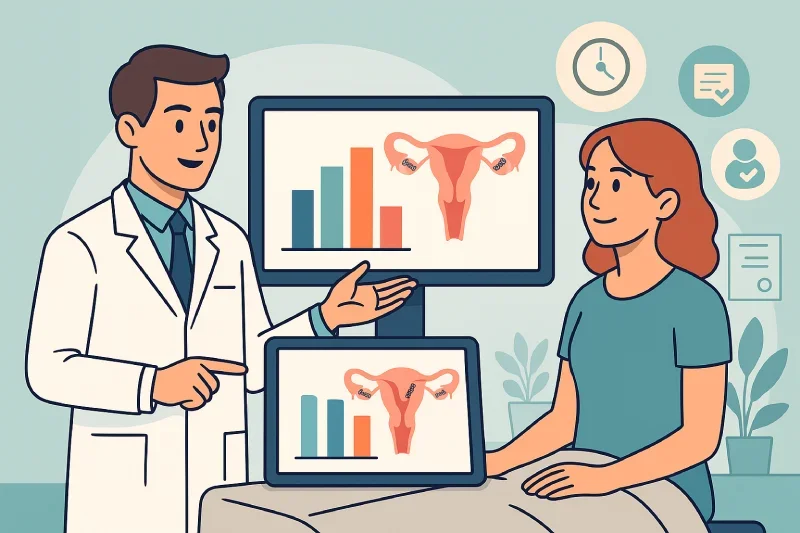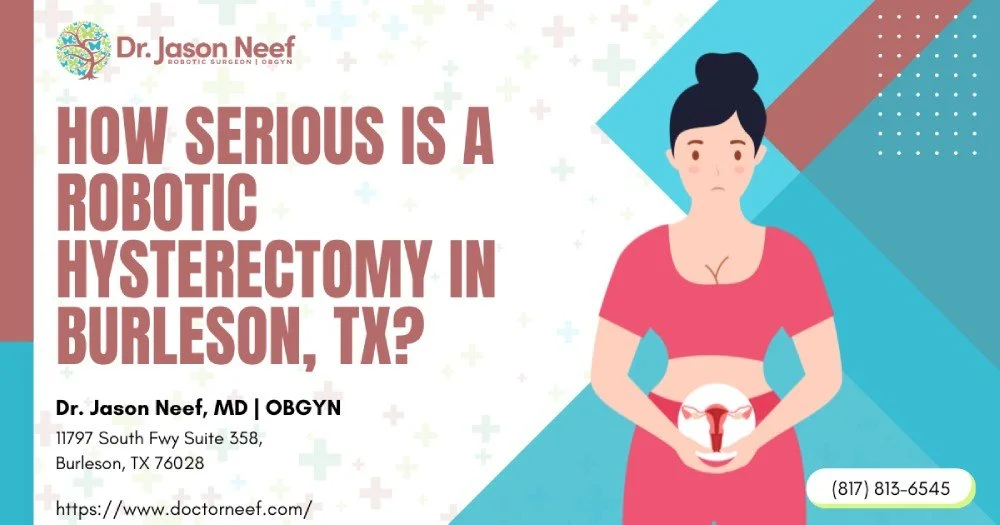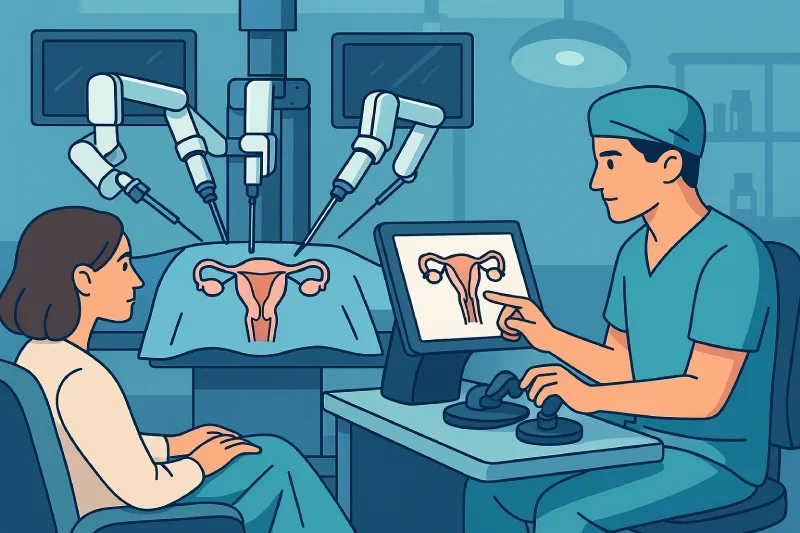Robotic Essure Reversal Success Rate and Statistics
Categories:
By: Ethan Cole
Essure was a permanent birth control device that the FDA removed from the market in 2018 due to safety concerns and reported side effects. Thousands of women who had this device implanted now seek reversal procedures, either to restore their fertility or address ongoing health issues.
Robotic-assisted Essure reversal has emerged as an advanced surgical option that combines the precision of robotic technology with minimally invasive techniques. This procedure involves removing the Essure device and reconnecting the fallopian tubes to restore natural fertility pathways.
Understanding the success rates and statistics behind robotic Essure reversal is crucial for women considering this procedure. Success can be measured in different ways: the technical success of restoring open fallopian tubes, actual pregnancy rates, and live birth outcomes. Each metric provides valuable insight into what patients can realistically expect from the procedure.
Key Takeaways
Robotic Essure reversal achieves 90% technical success rate for restoring tubal patency, enabling natural fertility pathways in most patients undergoing the procedure.
Pregnancy rates vary significantly from 38% to 78% depending on patient age, surgical expertise, and individual fertility factors affecting conception success.
Age remains the most critical factor influencing pregnancy outcomes, with younger women under 35 experiencing the highest success rates after reversal surgery.
Ectopic pregnancy risk ranges from 4% to 15% after robotic reversal, requiring careful monitoring during early pregnancy stages for patient safety.
Recovery is faster with robotic surgery, featuring same-day discharge and return to normal activities within 1-2 weeks compared to traditional methods.
Cost-effectiveness favors reversal for younger women wanting multiple children, while IVF may be better for older patients with time constraints.
Robotic Essure Reversal Success Rates: The Numbers That Matter
Success in Essure reversal can be measured in different ways. Technical success means the fallopian tubes are open and functional again. Clinical success means achieving pregnancy and live births. Understanding both types of success rates helps set realistic expectations.
Technical Success Rate: 90% Tubal Patency Restoration
Robotic-assisted Essure reversal achieves approximately 90% success in restoring tubal patency in expert hands. Tubal patency means the fallopian tubes are open and can allow eggs to travel from the ovaries to the uterus. This high technical success rate reflects the precision that robotic technology provides during the delicate microsurgical procedure.
The 90% rate represents the surgical ability to successfully remove the Essure device and reconnect the fallopian tubes in a way that restores their natural function. This measurement focuses purely on the mechanical success of the surgery itself.
Pregnancy Success Rates: What to Expect
Pregnancy rates after robotic Essure reversal vary significantly across different studies and medical centers. The variation depends on factors like patient selection, surgical technique, and follow-up periods.
Pregnancy Rate Ranges:
Individual center reports: 38% to 66%
Meta-analysis findings: 59% to 78%
Combined pregnancy rates across studies: approximately 66%
The lower end of these ranges may reflect more conservative patient selection or shorter follow-up periods, while higher rates often come from centers with extensive experience in robotic fertility procedures.
Comprehensive Success Rate Statistics
|
Success Metric |
Rate Range |
Notes |
|
Tubal Patency Restoration |
~90% |
Technical surgical success |
|
Pregnancy Rates |
38% - 78% |
Varies by study and center |
|
Combined Pregnancy Rate |
~66% |
Meta-analysis average |
|
Live Birth Rates |
32% - 58% |
Successful pregnancies to term |
|
Ectopic Pregnancy Risk |
4% - 9% |
Known risk with tubal surgery |
These statistics show that while the technical success of opening the tubes is high, achieving pregnancy involves additional biological factors beyond surgical success alone.
Factors That Influence Success Rates
Success rates for robotic Essure reversal vary significantly based on patient characteristics, surgical expertise, and other medical factors. Understanding these variables helps predict individual outcomes and set appropriate expectations.
Patient Age: The Most Critical Factor
Age plays the most significant role in determining pregnancy success after Essure reversal. Female fertility naturally declines with age, affecting both egg quality and quantity. This decline continues regardless of whether the fallopian tubes have been surgically restored.
Women under 35 typically experience the highest pregnancy rates after reversal surgery. Those between 35-40 see moderate success rates, while women over 40 face substantially lower pregnancy chances even with successful tube restoration. The 90% technical success rate for tubal patency remains consistent across age groups, but pregnancy outcomes vary dramatically.
Age also affects pregnancy complications and live birth rates. Older women face higher risks of miscarriage and pregnancy complications, which impacts the final live birth statistics even when initial pregnancy occurs.
Surgical Expertise and Center Experience
The complexity of robotic Essure reversal requires significant surgical skill and experience. Centers that perform these procedures regularly tend to report higher success rates than those with limited experience. This procedure involves delicate microsurgical techniques that improve with practice and specialization.
Surgeon expertise affects both technical success (tubal patency) and long-term outcomes. Experienced surgeons can better assess which patients are good candidates and perform more precise reconnections that optimize fertility potential.
The variation in reported pregnancy rates between centers (38% versus 66%) often reflects differences in surgical volume, technique refinement, and patient selection criteria.
Additional Medical Considerations
Several other factors influence success rates beyond age and surgical skill:
Partner Fertility Status: Male factor infertility affects approximately 30-40% of couples trying to conceive. Even with successful tube restoration, pregnancy requires both partners to have adequate fertility.
Time Since Sterilization: The length of time between original Essure placement and reversal surgery can affect outcomes. Longer periods may lead to more tissue changes or adhesions.
Overall Reproductive Health: Conditions like endometriosis, ovarian reserve, or previous pelvic infections impact fertility regardless of tube status.
Post-Surgery Healing: Individual healing responses affect how well the reconnected tubes function long-term.
The Robotic Advantage: Patient Benefits
Robotic technology transforms the Essure reversal experience for patients by reducing surgical trauma, improving recovery times, and enhancing overall outcomes. These benefits make the procedure more accessible and less disruptive to daily life.
Minimally Invasive Approach with Faster Recovery
Robotic Essure reversal requires only small incisions instead of large open surgery cuts. Patients typically experience less pain, reduced scarring, and faster healing compared to traditional surgical methods. Most women can return to normal activities within 1-2 weeks rather than the 4-6 weeks required for open surgery.
The outpatient nature of robotic surgery means patients go home the same day. This eliminates overnight hospital stays and reduces overall medical costs while allowing recovery in the comfort of home.
Reduced Surgical Complications
The precision of robotic instruments leads to less tissue damage during surgery. This results in lower rates of bleeding, infection, and other surgical complications. The enhanced visibility and control that surgeons have with robotic systems translates directly into safer procedures for patients.
Smaller incisions also mean reduced risk of wound complications and hernias that can occur with larger surgical openings.
Better Surgical Precision for Improved Outcomes
Robotic technology provides surgeons with 3D magnified vision and instruments that move with greater precision than human hands alone. This enhanced capability allows for more accurate reconnection of delicate fallopian tube structures.
The improved precision contributes to the high 90% success rate for restoring tubal patency. Better surgical outcomes mean patients are more likely to achieve their fertility goals without needing repeat procedures.
Enhanced Comfort During Recovery
Patients report less post-operative pain with robotic surgery compared to traditional open procedures. The reduced tissue trauma means less inflammation and faster return to normal function.
Many women can resume light activities within days rather than weeks, allowing them to maintain work and family responsibilities with minimal disruption.
The Procedure: What to Expect
Understanding the robotic Essure reversal process helps patients prepare mentally and physically for surgery. The procedure combines advanced technology with careful planning to achieve the best possible outcomes.
Pre-Surgery Preparation and Evaluation
Before surgery, patients undergo comprehensive fertility testing to ensure they are good candidates for reversal. This includes blood work to check hormone levels, imaging studies to assess the reproductive organs, and evaluation of overall health status.
Partners typically receive fertility testing as well, since male factor issues can affect success rates even with perfectly restored tubes. This complete evaluation helps surgeons predict individual success rates and discuss realistic expectations.
Patients receive detailed instructions about medications to avoid, dietary restrictions, and what to bring to the surgical center. Most centers require patients to arrange transportation home since they cannot drive after anesthesia.
Day of Surgery Experience
Robotic Essure reversal typically takes 2-4 hours depending on the complexity of each case. Patients receive general anesthesia and remain completely comfortable throughout the procedure.
The surgeon makes 3-5 small incisions in the abdomen to insert the robotic instruments and camera. Using 3D magnified vision, the surgeon carefully removes the Essure device from each fallopian tube and then performs microsurgical reconnection of the tube to the uterus.
The outpatient nature means patients recover in a comfortable post-surgery area before going home the same day. Most people feel ready to leave within 2-4 hours after the procedure ends.
Recovery Timeline and Expectations
First 24-48 Hours: Patients experience mild to moderate discomfort managed with prescribed pain medications. Rest is important, but light movement like walking is encouraged to prevent blood clots.
First Week: Most women can resume desk work and light activities. Driving is typically allowed once pain medications are no longer needed and movement feels comfortable.
2-4 Weeks: Normal activities can usually resume, including exercise and lifting restrictions being lifted. Follow-up appointments monitor healing progress.
6-8 Weeks: Full recovery is typically achieved. Patients can begin trying to conceive if desired, though some surgeons recommend waiting 2-3 months for optimal healing.
3-6 Months: Testing may be performed to confirm tubal patency and function before actively pursuing pregnancy.
Alternatives and Decision Making
Choosing between robotic Essure reversal and other fertility options requires weighing practical factors like cost, success rates, timeline, and personal circumstances. Making an informed decision involves understanding the real-world implications of each choice.
Cost Analysis: Reversal vs. IVF
Robotic Essure reversal typically costs $8,000-$15,000 as a one-time procedure. Most insurance plans do not cover fertility procedures, making this an out-of-pocket expense for most patients. However, successful reversal allows for multiple natural pregnancy attempts without additional medical costs.
IVF cycles cost $12,000-$20,000 per attempt, and most women require 2-3 cycles to achieve pregnancy. The total cost can easily reach $30,000-$60,000 for multiple attempts. Additional costs include medications ($3,000-$5,000 per cycle) and diagnostic testing.
For women under 35 with good fertility potential, reversal often provides better long-term value since it allows multiple natural conception attempts over several years.
Success Rate Comparison by Age
The decision between reversal and IVF heavily depends on age and associated success rates:
|
Age Group |
Robotic Reversal Pregnancy Rate |
IVF Success Rate Per Cycle |
Recommendation |
|
Under 35 |
60-75% |
45-55% |
Reversal often preferred |
|
35-40 |
40-60% |
35-45% |
Consider both options |
|
Over 40 |
20-35% |
15-25% |
IVF may be more efficient |
These rates assume normal male fertility and no other significant fertility factors.
Timeline Considerations
Robotic reversal requires 2-3 months healing before attempting pregnancy, then allows natural conception attempts indefinitely. Most pregnancies occur within 12-18 months after successful reversal.
IVF provides faster results with pregnancy possible within 2-3 months of starting treatment. However, failed cycles mean starting over with additional time and expense.
Women with limited time due to age may benefit more from IVF's immediate approach, while younger women can take advantage of reversal's long-term fertility restoration.
Insurance and Financial Planning
Most insurance plans exclude fertility treatments entirely. Some plans cover diagnostic testing but not the procedures themselves. Patients should verify coverage details before making decisions.
Many fertility clinics offer financing options or payment plans for both procedures. Some employers provide fertility benefits that may partially cover treatments.
The potential for multiple pregnancies after successful reversal can make it more cost-effective long-term, especially for families wanting more than one child.
Making an Informed Decision
The choice between robotic Essure reversal and other fertility options is deeply personal and depends on individual medical, financial, and lifestyle factors. Making the right decision requires honest evaluation of your situation and thorough discussion with qualified specialists.
Questions to Ask Your Doctor
About Your Specific Case:
What is my individual success rate based on my age and medical history?
How does my partner's fertility status affect our overall chances?
Are there any medical factors that make me a poor candidate for reversal?
How long should we try to conceive naturally before considering other options?
About the Surgeon and Center:
How many robotic Essure reversals do you perform annually?
What are your specific success rates for patients in my age group?
Can you provide references from previous patients?
What happens if the reversal is not successful?
About Realistic Expectations:
What is the timeline for attempting pregnancy after surgery?
How will we monitor whether the procedure was successful?
What are the signs that we should consider IVF instead?
Evaluating Your Individual Situation
Age and Time Factors: Women under 35 with partners under 40 typically have the best outcomes with reversal. Those over 38 should seriously consider whether IVF might provide faster results given declining fertility.
Financial Reality: Calculate total potential costs for both options. Consider that reversal allows unlimited natural attempts while IVF requires payment per cycle. Factor in time off work, travel costs, and medication expenses.
Family Planning Goals: Couples wanting multiple children often benefit more from reversal since it restores natural fertility long-term. Those wanting only one child might find IVF more predictable.
Emotional Readiness: Reversal requires patience since conception may take 12-18 months. IVF provides more immediate feedback but involves intensive medical monitoring.
Red Flags and When to Reconsider
Medical Red Flags:
Significant male fertility issues that won't improve with reversal
Advanced maternal age (over 42) where time is critical
Other fertility problems like severe endometriosis or poor ovarian reserve
Previous pelvic infections or surgeries that may complicate reversal
Practical Red Flags:
Surgeons with limited robotic reversal experience
Centers that cannot provide specific success rate data
Financial strain that would prevent multiple IVF cycles if reversal fails
Unrealistic expectations about guaranteed pregnancy
When IVF Makes More Sense:
Time pressure due to age or other factors
Known genetic issues requiring embryo testing
Severe male factor infertility
Previous failed reversal surgery
The best candidates for robotic Essure reversal are younger women with healthy partners who want multiple children and can afford to invest in long-term fertility restoration rather than immediate pregnancy.
Conclusion
Robotic Essure reversal achieves 90% technical success in opening fallopian tubes, with pregnancy rates ranging from 38% to 78% based on age and surgical expertise. While these statistics offer hope, success depends on individual factors including age, partner fertility, and choosing experienced surgeons. The minimally invasive procedure allows same-day discharge and faster recovery compared to traditional surgery. Younger women often benefit from long-term fertility restoration, while older patients may find IVF more predictable within shorter timeframes.
Ready to explore robotic Essure reversal? Dr. Jason Neef specializes in advanced robotic reproductive surgery and can provide personalized consultation about your specific success potential.
Contact Dr. Neef's office today to schedule your evaluation.
Schedule your robotic Essure reversal consultation with Dr. Neef today.
Call (817) 568-8731Categories:
Frequently Asked Questions
-
Pregnancy rates after robotic Essure reversal range from about 38% to 66.6%, with some studies showing a combined rate near 66%. Dr. Monteith's data indicates around 36% conceive within 12 months post-procedure. Rates vary by center and patient factors.
-
Robotic and laparoscopic reversal pregnancy rates are similar, typically 59%-78% for robotic versus 68%-75% for laparoscopic. Some studies show no significant difference in pregnancy outcomes between the two methods, though robotic surgery often has longer operative times.
-
Age is the most significant factor, with younger women exhibiting higher pregnancy rates. Other factors include tubal length and reproductive health. BMI shows inconclusive effects, and time from sterilization to reversal may impact outcomes minimally.
-
Ectopic pregnancy rates after robotic reversal range from 4% to 15%, similar to laparoscopic rates. Complications include risk of uterine rupture (rare) and recovery profiles compare favorably to open surgery. Robotic surgery offers high precision and fewer complications overall.
-
Pregnancies commonly occur within 6 to 12 months post-robotic reversal. About half of pregnancies happen within the first year, with some conceived even after several years. Early ovulatory cycles hold the highest chance for conception.
-
Risks include infection, bleeding, tubal damage, ectopic pregnancy, and rare uterine rupture. The surgical nature increases risks compared to non-surgical fertility treatments. Proper patient selection and surgical expertise help minimize complications.
-
Robotic surgery provides 3D magnification, enhanced dexterity, and improved precision, reducing tissue damage. It typically leads to faster recovery, less postoperative pain, and highly accurate microsurgical suturing compared to traditional laparoscopy or open surgery.
-
For younger women, robotic reversal can be more cost-effective than IVF, with potential for multiple pregnancies per surgery. For older women or those with fertility issues, IVF might offer better cumulative pregnancy chances.
-
Recovery is usually quick, with many patients discharged same day or the next. Return to normal activity occurs within 1-2 weeks, benefiting from minimally invasive robotic technique.
-
Postoperative monitoring includes tubal patency tests (HSG), fertility tracking through ovulation cycles, and early pregnancy scans to rule out ectopic pregnancy. Regular follow-up with a fertility specialist is advised.












